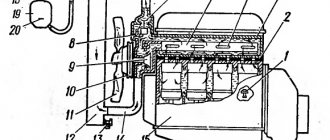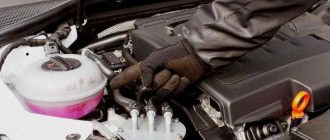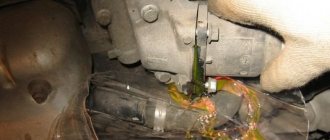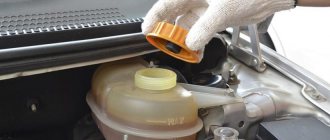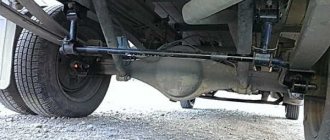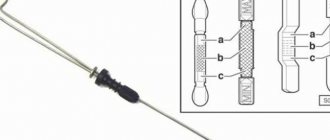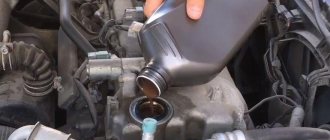The cooling system allows the engine to effectively maintain operating temperature and also ensures the removal of heat generated by the power plant. The entire system works thanks to the coolant circulating through it; it is the main transporter of heat from the internal combustion engine block to the cooling radiator.
Since any liquid expands when heated, it requires a tank of the same name, which allows you to retain all the refrigerant after increasing its volume.
Consequences of low or no antifreeze levels
An excessive amount of antifreeze leads to its leakage.
The antifreeze level in the expansion tank should be between two drawn lines indicating its minimum and maximum value. If the level is low, but the refrigerant is still present in the tank, then nothing bad will happen, since there is sufficient antifreeze in the radiator and cooling system.
The lack of antifreeze in the expansion tank can lead to serious overheating of the engine. Firstly, it is quite easy to air out the entire coolant circuit. This will immediately lead to local overheating of the power plant, most likely the coolant will boil, but this is only the most positive scenario. Most often, a complete lack of coolant leads to serious problems: the engine can easily seize due to severe overheating, the piston pins will stick to the pistons, and the compression and oil scraper rings will simply stop springing and become lodged in the piston. Secondly, the cylinder head gasket and the head plane will receive a portion of damage, after which the sealing element will have to be replaced, and the cylinder head will need to be milled. In the case of engines with an aluminum block, the damage will be much more serious.
Low antifreeze level
What does antifreeze affect?
Interestingly, the engine cooling solution expands like any other liquid. Its excess is sent to the expansion tank, which can be found under the hood. This process allows you to maintain the balance necessary for the normal operation of the power unit. The tank itself has special marks, and this is for a reason. Both a lack and an excess of coolant are equally dangerous for a car. For example, during the movement of antifreeze, the risk of formation of vapor locks, which can damage the engine, is reduced. If there is a lack of refrigerant, the engine overheats greatly, and this can disrupt the temperature regime of the cylinder head. In turn, the oil channels may collapse, and fuel consumption will probably creep up. The result may be “capital”. That is why it is necessary to ensure that the optimal level of antifreeze in the expansion tank is maintained.
What is antifreeze?
An attentive car enthusiast will probably notice that the coolant can have different colors, for example, red or green. The logical question is: is it possible to mix products with different shades? The answer is obvious - in no case, because this can significantly reduce the effectiveness of the final mixture. It is worth understanding that color is the result of adding dye. The main components have a completely different meaning. For example, most antifreeze is propylene or ethylene glycol (approximately 95%). The remainder is taken up by water and numerous additives. Perhaps the most important of them are corrosion inhibitors, which protect the unit itself and its elements from rust.
You may be interested in: SINTEC oils - confidence in the future
How to properly check the antifreeze level
Checking for the presence of antifreeze in the expansion tank is quite simple: you need to open the hood on a cold car and look at the coolant reservoir itself. It shows the risks that determine the minimum and maximum permissible amount of refrigerant. If the liquid does not go beyond these limits, then everything is in order. But it happens that there is not enough “freeze”, in which case it is necessary to add the “coolant” to the required values.
In modern cars, sensors are increasingly being installed that notify about the amount of technical fluids. Such a system will notify you if the antifreeze level is too low or if there is too much of it.
Why is it important to check your coolant level regularly?
The thermal regime of the internal combustion engine during operation varies depending on the load and ambient temperature. The coolant circulates in a small and large circle.
- When the engine warms up, the coolant does not leave the block and the head of the power unit. Thermostat is closed. Even when driving with a light load, a similar mode is possible; a similar phenomenon is observed at negative air temperatures outside
- The thermostat of different internal combustion engine models is adjusted to a specific mode. Opening occurs at t ≥ 88…93 ⁰С. When the coolant cools t ≤ 79…84 ⁰С, the thermostat closes.
- When the thermostat is open, the bulk of the coolant from the block and the block head is directed to the radiator, only a small part remains mixed in a small circle.
- During the cold period of vehicle operation, the interior heaters are turned on. Therefore, part of the heat from the engine coolant is transferred to the microclimate maintenance system.
When designing a power plant for certain types of vehicles, different devices and components are calculated. One of the important ones is the cooling system; it allows you to operate engines for a long period.
Subsequent tests help clarify the required parameters. For power plants with power up to 110…120 hp. The minimum volume of the expander is 1.8…2.6 liters. As power increases, the volume of the coolant expansion tank also increases. In the largest vehicles - mining vehicles, the volume of the expansion tank reaches up to 12-14 liters.
The engine life of modern internal combustion engines exceeds 15-20 thousand hours of active operation. There are samples that show durability records. A mileage of a million or more kilometers is typical not only for foreign cars; even domestic vehicles have demonstrated similar results. The normal functioning of the cooling system plays an important role here.
Checking the coolant level does not require much time. Just open the hood (engine compartment lid) and look at the expansion tank. They are made of white translucent plastic. Antifreeze is specially painted in different colors to make it easier to control the level without opening the cap. They focus on the indicators printed on the surface of the container. Most cars have marks:
- MIN – minimum;
- MAX – maximum.
When refueling, they try to fill in such a way that, under normal conditions and a cold engine, the actual level is 1...2 cm above the MIN mark.
Attention! A sharp increase or decrease in the coolant level in the car indicates a malfunction that needs to be addressed urgently.
Types of malfunctions and position of liquid in the tank
A sharp drop in level indicates that there is an antifreeze leak. It may leak:
- inside the cylinder. A similar phenomenon occurs when the block head or the gasket installed between the block and the upper part is damaged;
- on some car models, when the head overheats, the geometry of the plane of contact between the engine elements is disrupted. When topping up, antifreeze penetrates into the cracks formed. In addition to fuel, liquid appears in the cylinders. The power plant fails;
- destruction of the block head occurs when water is used instead of coolant in winter. The internal combustion engine is defrosting. Operation is impossible, the damaged element needs to be replaced;
- into the crankcase if there is internal damage to the block. The phenomenon is rare, but sometimes this is how metal fatigue manifests itself;
- when the seal between the block and the cylinder liners is lost. If the engine overheats due to a lack of coolant in the system, then displacement occurs in the sealing elements. When you subsequently pour antifreeze into the system, it penetrates into the opened leaks and cracks;
- If the pipelines and hoses connecting the radiator and heater are damaged, antifreeze quickly leaks. The car cannot be operated; the engine will overheat, which will require replacement or expensive repairs;
- damage to the radiator will lead to leaks through it. Similar phenomena occur as a result of road accidents. You won't be able to leave on your own. The heat exchange device needs to be replaced;
- overheating of the cylinders due to changes in the ignition timing. The operating mode changes so much that the coolant cannot remove the excess heat flow generated during fuel combustion. Similar phenomena were characteristic of the Moskvich and Tavria engines;
- failure of the cooling system pump. Circulation in a large circle is impossible. An intensive increase in coolant level is noticeable in the expansion tank. Such failures sometimes occur when driving for a long time in traffic jams, when starting and stopping occur constantly.
Not only a decrease in antifreeze levels indicates problems. Sometimes you can see an increase in the amount of fluid:
- flow of some fuel into the cooling system. The phenomenon is rare, but sometimes it is possible. Occurs more often in diesel engines. Fuel enters through leaks at the mounting location of the high-pressure pump. A sign is a change in color or clouding of the coolant;
- flow of engine oil into the cooling system. Similar cases are possible after an accident, when the elements of the block are displaced.
What determines the volume of coolant in the system?
The volume of coolant in the circuit depends directly on its temperature and weather conditions. In the hot season, as a rule, the coolant in the expansion tank will always be close to the MAX mark, while in winter it can be seen at the MIN mark. This is explained by the change in the volume of the liquid depending on its temperature: the colder it is, the less V.
The ideal amount of coolant in the expansion tank
Why is verification needed?
Temperature fluctuations can be quite significant and in practice the difference sometimes reaches 150° C. For example, if the engine housing in operating mode heats up to +110° C, and the air outside is 40° C. Naturally, water is not suitable for these purposes, but cooling the liquid has the required characteristics.
Timely checking of its level is one of the basic criteria when servicing a car. It is necessary to provide the following parameters:
- Security. Overheating can cause unexpected breakdowns while driving, which can lead to extremely undesirable consequences.
- Economical. This procedure will save the car owner from expensive repairs caused by premature wear of car parts and components.
- Reliability. In winter, operating a modern car is impossible without antifreeze. An insufficient level of this liquid is extremely dangerous; it is no coincidence that the literal translation from English of this concept means “non-freezing”.
You can check the coolant level every time there is a reason to open the hood. It is recommended to regularly monitor its quantity, at least 2 times a year. A complete fluid change is done every 2-3 years.
What affects the coolant level?
The required amount of antifreeze keeps the vehicle systems in optimal condition. The characteristics declared by the manufacturer are achievable only at the recommended coolant level and directly affect the following parameters:
Boiling point. The calculated value is about 110° C. It is not recommended to warm up the engine above this value. The cooling system is designed in such a way that the continuous flow of coolant in a circle through the radiator and the power unit duct system maintains a temperature balance from 60° C to 108° C. Starting the engine
During the cold season, it is important that the antifreeze is mobile in the system. Water at temperatures below zero turns into ice, and the route of its movement in this case will be blocked, which will lead to overheating of the engine
Antifreeze and antifreeze, depending on the brand, do not freeze at temperatures down to -65°C. In most cases, the service life of coolant rated up to -40°C is sufficient; Operation of the hydraulic transmission system. In many modern cars with automatic transmission, it is necessary to maintain optimal temperature in the transmission. Coolant in this case is the most effective solution to the problem. Additives and additives in the composition of coolant. They give it additional qualities, and this, first of all, affects its anti-corrosion properties. In addition, the balanced composition prevents the formation of scale and has a lubricating effect.
How much antifreeze should there be?
The functions performed by the coolant are important in both summer and winter, so regular inspection of the system is an urgent need. The lack or substandard quality of this fluid depletes the engine's life, and in some cases, leads to breakdown and, as a result, to expensive and troublesome repairs.
You can check the status of the system in absolutely any car. This is not a difficult task, since machine manufacturers provide unhindered access to the control device.
Exact information about the volume of coolant for a specific model is indicated in the car's passport. It is also easy to find in specialized tables on thematic websites or by consulting with a mechanic or sales manager.
It is important to remember this rule: mixing antifreezes of different compositions is not recommended. You need to know the brand of your coolant, and in all doubtful cases, contact a specialist
Otherwise you will have to do a complete fluid change.
You need to know the brand of your coolant, and in all doubtful cases, contact a specialist. Otherwise, you will have to do a complete fluid change.
If, for example, blue antifreeze is filled, then you cannot add red.
But you shouldn’t focus only on color either. Different manufacturers use their own exclusive developments, but no one can guarantee the compatibility of ingredients with the same color.
What should be the normal volume of coolant?
The amount of antifreeze depends on the car engine size. For example, engines up to 2 liters can accommodate up to 5-7 liters of antifreeze. And more serious units require 10 or more kg of refrigerant to be filled.
Antifreeze volume depending on the vehicle:
| Antifreeze volume | Vehicle type |
| 3 l | Daihatsu Mira, More, Opti, Suzuki Alto, Wagon-R, Honda Life, Subaru Pleo |
| 4 l | Daihatsu Atrai, Mitsubishi Strada 1300CC., Vitz1300CC., FUNCARGO1500CC., Daihatsu Terios 1300CC., Toyota BB 1500CC., Nissan March 1300cc., Honda Civic 1500cc., HR-V 1600C. Domani 1600CC., Mitsubishi Toppo BJ, Pajero |
| 5 l | Toyota Starlet 1300cc., Tercel 1500cc., Raum 1500cc., Corolla Spacio 1600cc., Corolla II 1500cc., Nissan Lucino 1500cc., Avenir 1800cc., Mitsubishi Mirage 1500cc., Suzuki Escudo 1600cc., Nissan Cube 1300cc., Honda Logo 130 0cc . |
| 6 l | Toyota Corolla 1600, Curren 1800, Nadia 2000, Gaia 2000, Ipsum 2000, Levin Trueno 1600, Opa 1800, Vista 2000, Mazda Demio 1500, Familia 1800, Nissan Sunny 1800, Primera 2000, Mitsubishi Lancer 1800, Subaru Legacy 2500, Honda CR -V 2000, Torneo 2000, Step wagon 2000, Mitsubishi Legnum 2000, Pajero 10 2000 |
| 7 l | Toyota RAV-4 2000, Altezza 2000, Celica 2000, Mark II2000, Camry Gracia 2200, Caldina 2000, Crown 2500, Progres 2500, Honda Odyssey 2300, Inspire 2500, Mitsubishi RVR 2000 |
| 8 l | Toyota: Aristo ZOOOSs., Crown ZOOOSs., Majesta ZOOOSs., Soarer ZOOOSs., Hilux SURF 3400cc., Mark II 2500Tcc., Mitsubishi: GTO ZOOOSs., Chariot Grandis ZOOOSs., Suzuki Escudo 2500cc., Nissan Bassara ZOOOSs., Mitsubishi Diamante 2500cc., Nissan Presage ZOOOSs., Mazda Tribute 2000cc. |
| 9 l | Toyota: Soarer2500Tcc., Windom ZOOOSs., Kiuger ZOOOSs., Harrier ZOOOSs., Estima ZOOOSs., Nissan: Cedric - Gloria ZOOOSs., Laurel 2500cc., Mazda Sentia ZOOOSs., Mitsubishi Pajero ZOOOSs., Nissan Skyline 2500cc. |
| Over 10 l | Toyota: Majesta 4000cc. (10), MR-S (10), Celsior 4000cc. (11), Granvia 3400cc., Regius 2700cc. (12), MR-2 2000cc. (13), Nissan Stagea 2500cc. (10), Mazda MPV 2500cc. (10),Isuzu Wizard (11) Nissan: Terrano ZZOOSs. (eleven |
The normal amount of coolant is quite easy to determine. The engine should be warmed up to 20 degrees Celsius. Then open the hood and look at the tank - the optimal value for antifreeze will be a fictitious line located in the middle between the limiting marks. In this case, the antifreeze will never pour out through the expansion tank, but it will always be at least below the minimum level, even in severe frost.
Possible leak locations
As a rule, antifreeze leaks out at the joints of the pipes, since the pressure in a normally operating system reaches 1 bar when heated. Usually, coolant leaks are immediately visible at the joints. To eliminate leaks, it is recommended to tighten all the clamps on the pipes.
Over time, rubber products crack and become unusable. Antifreeze in such places can simply gush out under pressure. To prevent such a situation, it is necessary to regularly inspect the cooling system pipes for defects.
A common culprit for antifreeze leaks is the engine pump. When worn, it begins to flow through a special hole. If a refrigerant leak appears at the bottom of the pump, this indicates wear of the water pump seal. In this case, only replacing the faulty element will help.
Leaks can often occur due to leaky radiators. Diagnosing them is extremely simple: visually inspect all the honeycombs and radiator tanks. If no antifreeze is noticed, then everything is in order.
How to control the level of antifreeze in the system
The level must be checked in accordance with the vehicle operating instructions. But there are also general considerations.
In the cold
The engine must cool down before checking. Then the marks on the expansion tank will give the correct information. In principle, the level can be anything between the minimum and maximum marks on the wall of the transparent tank.
Ideally - approximately in the middle; excess is also harmful. It is important to track not the millimeters of this level, but the approximate dynamics of its change, which can show that the liquid is leaving, which means we need to look for the cause.
It can go away even if the system is completely sealed, but this happens very slowly, the level does not change for months and years.
Hot
It would be a big mistake to carry out inspections on a hot engine that has just been stopped, especially while it is running.
This is due to a number of reasons:
- the heated liquid, and there is quite a lot of it in the system, is expanded, which means the level will be deceptively high;
- The formation of vapor locks in the system will be even more misleading; antifreeze does not boil, but the pressure necessary for this is created by the formation of gas bubbles in the hottest areas of the jackets, especially immediately after stopping the engine, when circulation from the water pump stops, and the parts have a very high temperature;
- the release of gas bubbles makes it difficult to read the level scale correctly.
It is even more dangerous to open the reservoir cap when the engine is hot. A sudden loss of pressure will cause the release of steam and hot liquid, which can cause burns.
How to properly add coolant to the expansion tank
Adding fluid to the expansion tank to the required level is a simple procedure. The first step is to open the hood and make eye contact with the antifreeze reservoir. The refrigerant level is then checked. If it is too low, open the filler cap of the expansion tank and add coolant to the required level.
Only proven antifreeze should be added - preferably the one that is currently circulating through the system. Not all antifreezes can be mixed. Just because they are the same color does not mean that they will not react when combined.
How to find out the coolant level
When the engine is still cold, remove the radiator cap. Look carefully at the amount of antifreeze at the bottom edge of the outlet to which the hose leading to the tank is connected.
Now pay attention to the expansion tank itself. Antifreeze ideally should be between its minimum and maximum marks.
If you notice that the amount of liquid is below the minimum indicator, you must immediately add antifreeze. Without doing this, you risk overheating the car engine.
If the volume of liquid suddenly drops, you need to check it again. Start and warm up the engine to ninety degrees, then cool it, since the level of antifreeze may differ between cold and hot temperatures due to the fact that hot liquid tends to expand. If the volume of antifreeze in the tank drops after such a procedure, it should be assumed that perhaps the reason is that the integrity of the system has been compromised. This means that more detailed diagnostics are required.
What determines the level of antifreeze
- tightness of all elements of the cooling system: expansion tank, all tubes, as well as gaskets and cylinder block;
- fixing the hoses with clamps in the correct position;
- proper functioning of the valves on the expansion tank and radiator caps;
- proper functioning of the fuel system;
- antifreeze quality;
- driving method;
- ignition system.
If the coolant level is low, engine power may decrease and fuel consumption may increase.
. The reason for all this may be poorly secured clamps. It is through them that antifreeze most likely flows out.
If the radiator valves malfunction, the cooling system will have lower pressure than necessary. This will cause a decrease in the boiling point of the antifreeze, resulting in the risk of vapor locks forming. The same outcome is expected if the hose that leads to the coolant reservoir is clogged. Therefore, the cooling system must be carefully monitored
.
So, we have provided information regarding the presence of fluid in the cooling system and given examples of possible malfunctions due to a lack of coolant. We hope that our article was useful to you, and you were able to glean the necessary information for yourself from it.
← Previous material
Next material →
Is it possible to mix different antifreezes?
Due to the huge range of coolants, car enthusiasts are increasingly mixing two or three incompatible substances. In this case, the output is a strange-colored liquid with sediment or foam; often the “frieze” turns into an emulsion. In general, the consequences of such mixing are extremely disastrous. If you are going to mix different refrigerants, you should clearly understand their compatibility.
Antifreeze miscibility table:
| Coolant in the system | |||||||
| Antifreeze | G11 | G12 | G12+ | G12++ | G13 | ||
| Coolant for topping up the system | Antifreeze | Yes | Yes | Not | No | No | No |
| G11 | Yes | Yes | No | No | No | No | |
| G12 | No | No | Yes | No | No | No | |
| G12+ | Yes | Yes | Yes | Yes | No | No | |
| G12++ | Yes | Yes | Yes | Yes | Yes | Yes | |
| G13 | Yes | Yes | Yes | Yes | Yes | Yes |
The most accurate and visual method is mixing antifreeze in a transparent container. This option immediately shows the possibility of combining two refrigerants
By referring to this table, it is easy to determine whether it is possible to mix the 2 liquids you have chosen. If you don’t know what kind of antifreeze is used in your car’s cooling system, then the best option would be to add distilled water to the system, thereby simply diluting the existing coolant. The only consequences are a decrease in the protective properties of antifreeze, as well as a narrowing of the temperature range.
If you have any questions, leave them in the comments below the article. We or our visitors will be happy to answer them
You may also be interested
Sintec Multifreeze - one for all
Modern technologies make our lives easier. Think back to cell phones from the early 2000s: most of them had their own connectors and original chargers. But then manufacturers came to a single universal solution in the form of microUSB, which significantly simplified the operation of smartphones. There are similar examples in the automotive industry. Do you know how to choose the right antifreeze for topping up? Some are guided [...]
Is it possible to mix G11 and G12 antifreezes?
When switching from one antifreeze to another, the ideal option would be to completely drain the old one, flush the cooling system and fill in the new one. However, it is not always possible to do this. Therefore, for many drivers the relevant question is: how safe will it be to mix different coolants?
